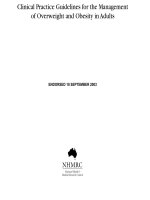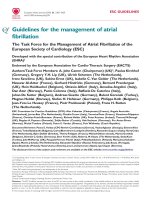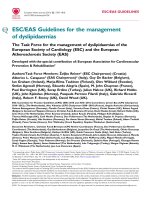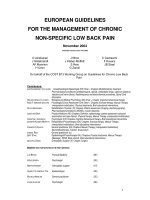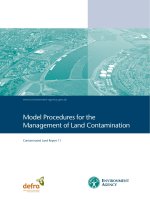AHA ACC guideline for the management of adults with congenital heart disease
Bạn đang xem bản rút gọn của tài liệu. Xem và tải ngay bản đầy đủ của tài liệu tại đây (1.08 MB, 91 trang )
2018 AHA/ACC Guideline for the
Management of Adults With Congenital
Heart Disease (ACHD)
© American College of Cardiology Foundation and American Heart Association, Inc.
Publication Information
This slide set is adapted from the 2018 AHA/ACC Guideline for
the Management of Adults With Congenital Heart Disease
Published on August 16, 2018, available at: Circulation and
Journal of the American College of Cardiology.
The full-text guidelines are also available on the following
websites: AHA (professional.heart.org) and ACC (www.acc.org)
2018 Adults With Congenital Heart Disease Guideline
Writing Committee
Karen K. Stout, MD, FACC, Chair†
Curt J. Daniels, MD, Vice Chair*†‡
Jamil A. Aboulhosn, MD, FACC, FSCAI*§
Stephanie Fuller, MD, MS, FACC#
Biykem Bozkurt, MD, PhD, FACC, FAHA║
Michelle Gurvitz, MD, FACC**
Craig S. Broberg, MD, FACC*†
Paul Khairy, MD, PhD*†
Jack M. Colman, MD, FACC†
Michael J. Landzberg, MD, FACC*†
Stephen R. Crumb, DNP, AACC†
Arwa Saidi, MB, BCH, FACC*†
Joseph A. Dearani, MD, FACC¶
Anne Marie Valente, MD, FACC, FAHA, FASE††
George F. Van Hare, MD‡‡
†ACC/AHA Representative. ‡International Society for Adult
Congenital Heart Disease Representative. §Society for
Cardiovascular Angiography and Interventions. ║ACC/AHA Task
Force on Clinical Practice Guidelines Liaison. ¶Society of
Thoracic Surgeons Representative. #American Association for
Thoracic Surgery Representative. **ACC/AHA Task Force on
Performance Measures Liaison. ††American Society of
Echocardiography Representative. ‡‡Heart Rhythm Society
Representative.
Applying Class of
Recommendation and
Level of Evidence to
Clinical Strategies,
Interventions,
Treatments, or
Diagnostic Testing
in Patient Care*
(Updated August 2015)
Systematic Reviews on ACHD
• “Medical Therapy for Systemic Right Ventricles:
A Systematic Review (Part 1)
• “Interventional Therapy Versus Medical Therapy
for Secundum Atrial Septal Defect: A Systematic
Review (Part 2)
ACHD AP CLASSIFICATION
(CHD Anatomy + Physiological Stage = ACHD AP Classification)
• CHD Anatomy
(This list is not meant to be comprehensive; other conditions may be important in individual patients. ASD, atrial septal defect; AVSD,
atrioventricular septal defect; CCTGA, congenitally corrected transposition of the great arteries; CHD, congenital heart disease; d-TGA, dextrotransposition of the great arteries; FC, functional class; HCM, hypertrophic cardiomyopathy; l-TGA, levo-transposition of the great arteries;
NYHA, New York Heart Association; TGA, transposition of the great arteries; and VSD, ventricular septal defect. )
I: Simple
Native disease
• Isolated small ASD
• Isolated small VSD
• Mild isolated pulmonic stenosis
Repaired conditions
• Previously ligated or occluded ductus arteriosus
• Repaired secundum ASD or sinus venosus defect without significant residual shunt or chamber
enlargement
• Repaired VSD without significant residual shunt or chamber enlargement
(Con’t.)
ACHD AP CLASSIFICATION
• CHD Anatomy
II: Moderate Complexity
Repaired or unrepaired conditions
•
Aorto-left ventricular fistula
•
Anomalous pulmonary venous connection, partial or total
•
Anomalous coronary artery arising from the pulmonary artery
•
Anomalous aortic origin of a coronary artery from the opposite sinus
•
AVSD (partial or complete, including primum ASD)
•
Congenital aortic valve disease
•
Congenital mitral valve disease
•
Coarctation of the aorta
•
Ebstein anomaly (disease spectrum includes mild, moderate, and severe variations)
•
Infundibular right ventricular outflow obstruction
•
Ostium primum ASD
•
Moderate and large unrepaired secundum ASD
•
Moderate and large persistently patent ductus arteriosus
•
Pulmonary valve regurgitation (moderate or greater)
•
Pulmonary valve stenosis (moderate or greater)
•
Peripheral pulmonary stenosis
•
Sinus of Valsalva fistula/aneurysm
•
Sinus venosus defect
•
Subvalvar aortic stenosis (excluding HCM; HCM not addressed in these guidelines)
•
Supravalvar aortic stenosis
•
Straddling atrioventricular valve
•
Repaired tetralogy of Fallot
•
VSD with associated abnormality and/or moderate or greater shunt
(Con’t.)
ACHD AP CLASSIFICATION
• CHD Anatomy
III: Great Complexity (or Complex)
•
•
•
•
•
•
•
•
•
•
Cyanotic congenital heart defect (unrepaired or palliated, all forms)
Double-outlet ventricle
Fontan procedure
Interrupted aortic arch
Mitral atresia
Single ventricle (including double inlet left ventricle, tricuspid atresia, hypoplastic left
heart, any other anatomic abnormality with a functionally single ventricle)
Pulmonary atresia (all forms)
TGA (classic or d-TGA; CCTGA or l-TGA)
Truncus arteriosus
Other abnormalities of atrioventricular and ventriculoarterial connection (i.e.,
crisscross heart, isomerism, heterotaxy syndromes, ventricular inversion)
(Con’t.)
ACHD AP CLASSIFICATION
• Physiological State
A
•
•
•
•
•
NYHA FC I symptoms
No hemodynamic or anatomic sequelae
No arrhythmias
Normal exercise capacity
Normal renal/hepatic/pulmonary function
B
•
•
•
•
•
•
NYHA FC II symptoms
Mild hemodynamic sequelae (mild aortic enlargement, mild ventricular
enlargement, mild ventricular dysfunction)
Mild valvular disease
Trivial or small shunt (not hemodynamically significant)
Arrhythmia not requiring treatment
Abnormal objective cardiac limitation to exercise
(Con’t.)
ACHD AP CLASSIFICATION
• Physiological Stage
C
•
•
•
•
•
•
•
•
•
•
•
•
•
•
•
•
NYHA FC III symptoms
Significant (moderate or greater) valvular disease; moderate or greater ventricular
dysfunction (systemic, pulmonic, or both)
Moderate aortic enlargement
Venous or arterial stenosis
Mild or moderate hypoxemia/cyanosis
Hemodynamically significant shunt
Arrhythmias controlled with treatment
Pulmonary hypertension (less than severe)
End-organ dysfunction responsive to therapy
D
NYHA FC IV symptoms
Severe aortic enlargement
Arrhythmias refractory to treatment
Severe hypoxemia (almost always associated with cyanosis)
Severe pulmonary hypertension
Eisenmenger syndrome
Refractory end-organ dysfunction
2018 ACHD Clinical Practice Guidelines
Access to Care
Access to Care
COR
LOE
B-NR
I
C-EO
Recommendation for Access to Care
Recommendation
Physicians caring for patients with ACHD should support access to
care by 1) assuring smooth transitions for adolescents and young
adults from pediatric to adult providers (Level of Evidence: B-NR);
and 2) promoting awareness of the need for lifelong specialized
care through outreach and educational programs (Level of
Evidence: C-EO).
2018 ACHD Guideline
Delivery of Care
Delivery of Care
COR
LOE
I
B-NR
I
C-LD
Recommendations for Delivery of Care
Recommendations
Patients with ACHD AP classification IB-D, IIA-D, and IIIA-D*
should be managed in collaboration with an ACHD cardiologist .
Cardiac
surgery,
catheter-based
interventional
cardiac
procedures, and electrophysiological procedures involving
congenital heart lesions in patients with ACHD should be
performed by operators with expertise in CHD procedures and in
collaboration with an ACHD cardiologist.
*See details on the ACHD Anatomic and Physiological classification system.
2018 ACHD Guideline
Evaluation of Suspected and Known CHD
Electrocardiogram
Recommendations for Electrocardiogram
COR
I
I
LOE
Recommendations
C-EO
A standard 12-lead electrocardiogram (ECG) is recommended in adults
with CHD with serial assessment depending on the specific ACHD AP
classification or when symptoms develop or worsen.
C-EO
Ambulatory electrocardiographic monitoring should be performed in
patients with CHD who are at risk of tachyarrhythmia, bradyarrhythmia or
heart block, or when symptoms possibly of arrhythmic origin develop.
(Con’t.)
Ionizing Radiation principles
Recommendation for Ionizing Radiation Principles
COR
I
LOE
Recommendation
B-NR
Strategies to limit and monitor radiation exposure are recommended
during imaging of patients with ACHD, with studies not involving
ionizing radiation chosen whenever appropriate.
(Con’t.)
Echocardiography
Recommendations for Echocardiography
COR
I
I
LOE
Recommendations
B-NR
Intraoperative TEE is recommended to guide surgical repair of CHD in
adults.
C-EO
Patients with ACHD should undergo transthoracic echocardiography
(TTE) for initial assessment, with timing of serial assessment based on
anatomic and physiological severity and clinical status.
(Con’t.)
CMR Imaging
Recommendations for CMR Imaging
COR
LOE
I
B-NR
IIa
C-LD
Recommendations
In patients with ACHD who have or who are at risk of developing RV
enlargement and dysfunction, serial CMR is recommended for quantitative
assessment of RV size and function.
CMR can be useful in the initial evaluation and serial assessment of
selected patients with CHD based on anatomic complexity and clinical
status.
Cardiac Computed Tomography
Recommendation for Cardiac Computed Tomography
COR
IIa
LOE
Recommendation
C-LD
CCT imaging can be useful in patients with ACHD when information
that cannot be obtained by other diagnostic modalities is important
enough to justify the exposure to ionizing radiation.
Cardiac Catheterization
Recommendations for Cardiac Catheterization
COR
LOE
I
C-LD
IIa
B-NR
Recommendations
Cardiac catheterization (hemodynamic and/or angiographic) in patients
with ACHD AP classification II and III, or interventional cardiac
catheterization in patients with ACHD AP classification I to III should be
performed by, or in collaboration with, cardiologists with expertise in
ACHD.
In patients with a low or intermediate pretest probability of coronary
artery disease (CAD), use of CT coronary angiography is reasonable to
exclude significant obstructive CAD when cardiac catheterization has
significant risk or because of patient preference.
Exercise Testing
Recommendations for Exercise Testing
COR
LOE
IIa
B-NR
IIa
C-LD
Recommendations
In patients with ACHD, cardiopulmonary exercise testing (CPET) can be
useful for baseline functional assessment and serial testing.
In symptomatic patients with ACHD, a 6-minute walk test can be useful
to objectively assess symptom severity, functional capacity, and
response to therapy.
2018 ACHD Guideline
Transition Education
Transition Education
Recommendation for Transition Education
COR
I
LOE
Recommendation
B-NR
Clinicians caring for patients with CHD should deliver developmentally
appropriate transition education to adolescent and young patients with CHD,
and to their families/support network.
2018 ACHD Guideline
Exercise and Sports



